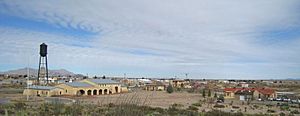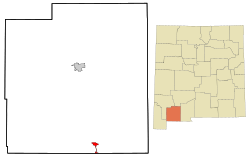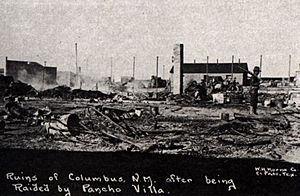Columbus, New Mexico facts for kids
Quick facts for kids
Columbus, New Mexico
|
|
|---|---|
|
Village
|
|

View of Columbus from Pancho Villa State Park
|
|

Location of Columbus, New Mexico
|
|
| Country | United States |
| State | New Mexico |
| County | Luna |
| Founded | 1891 |
| Area | |
| • Total | 4.67 sq mi (12.09 km2) |
| • Land | 4.67 sq mi (12.09 km2) |
| • Water | 0.00 sq mi (0.00 km2) |
| Elevation | 4,072 ft (1,241 m) |
| Population
(2020)
|
|
| • Total | 1,442 |
| • Density | 309.04/sq mi (119.32/km2) |
| Time zone | UTC-7 (Mountain (MST)) |
| • Summer (DST) | UTC-6 (MDT) |
| ZIP code |
88029
|
| Area code(s) | 575 |
| FIPS code | 35-17050 |
| GNIS feature ID | 2413542 |
Columbus is a small village in New Mexico, United States. It is located in Luna County. The village is about 3 miles (5 km) north of the Mexican border.
Columbus is known for an important historical event. In 1916, a Mexican general named Pancho Villa attacked the village. This attack led the United States to send many soldiers into Mexico. The population of Columbus was 1,442 people in 2020.
Contents
History of Columbus
How Columbus Started (1891–1910s)
Columbus was founded in 1891. It was built right next to the Mexican border, across from a town called Palomas, Chihuahua. The village was named after the famous explorer Christopher Columbus.
In 1902, the village moved about 3 miles (5 km) north. This happened when the El Paso and Southwestern Railroad built a train station there. Today, this old train station is a museum. It is run by the Columbus Historical Society.
Around 1905, Columbus was a very small town. It had only about 100 people. There was one general store and a saloon. Over time, the town grew. A high school was built. A local newspaper, the Columbus News, also started.
By 1915, Columbus had about 700 residents. A bank, four hotels, and several stores were built. A Baptist church was also established. The area around Columbus was also rich in metals like silver and copper.
The 1916 Pancho Villa Attack
On March 9, 1916, a big event happened in Columbus. Mexican revolutionary leader Pancho Villa ordered an attack on the town. About 500 of his men attacked Columbus. The town was protected by soldiers from the 13th Cavalry Regiment.
Villa's army burned part of the town. They also killed some soldiers and residents. After the attack, they went back into Mexico.
The President of the United States, Woodrow Wilson, reacted quickly. He sent 10,000 soldiers into Mexico. These soldiers were led by General John J. Pershing. Their goal was to find Pancho Villa. This mission was called the Punitive Mexican Expedition.
The expedition did not find Villa. He managed to escape. However, this event brought a lot of attention to Columbus. It also showed that war could reach the border of the United States.
Changes After 1926
After the Punitive Expedition ended in 1926, Columbus began to change. The army camp, Camp Furlong, became much less active. Eventually, the army closed the camp. The El Paso and Southwestern Railroad also stopped its service to Columbus. These changes caused the town's economy to slow down.
In the 1990s, Columbus started to improve again. New city and state parks were developed. Museums and RV parks were also built. The town began to highlight its rich history.
Geography
Columbus is located in the southern part of Luna County. It is about 3 miles (5 km) north of the border with Mexico. The village actually reaches all the way to the international border. Across the border is the Mexican village of Puerto Palomas, Chihuahua.
New Mexico State Road 11 goes north from Columbus. It leads 32 miles (51 km) to Deming. Deming is the main town in Luna County. State Road 9 goes east and west from Columbus. It leads to other towns like Santa Teresa and Hachita.
The village of Columbus covers a total area of about 4.67 square miles (12.1 square kilometers). All of this area is land.
Climate
Columbus has a cold semi-arid climate. This means it is generally dry with some cold periods. This type of climate is common in many lower areas of New Mexico.
| Climate data for Columbus (Columbus Municipal Airport), elevation: 1,268 m or 4,160 ft, 1981–2010 normals, extremes 1923–2011 | |||||||||||||
|---|---|---|---|---|---|---|---|---|---|---|---|---|---|
| Month | Jan | Feb | Mar | Apr | May | Jun | Jul | Aug | Sep | Oct | Nov | Dec | Year |
| Record high °F (°C) | 80 (27) |
86 (30) |
91 (33) |
98 (37) |
105 (41) |
111 (44) |
109 (43) |
107 (42) |
103 (39) |
96 (36) |
86 (30) |
80 (27) |
111 (44) |
| Mean maximum °F (°C) | 71.0 (21.7) |
76.5 (24.7) |
82.4 (28.0) |
89.4 (31.9) |
96.9 (36.1) |
104.2 (40.1) |
103.9 (39.9) |
100.0 (37.8) |
96.5 (35.8) |
89.3 (31.8) |
79.0 (26.1) |
71.0 (21.7) |
105.0 (40.6) |
| Mean daily maximum °F (°C) | 59.4 (15.2) |
64.8 (18.2) |
71.9 (22.2) |
80.0 (26.7) |
89.1 (31.7) |
96.9 (36.1) |
96.1 (35.6) |
93.0 (33.9) |
89.2 (31.8) |
80.2 (26.8) |
68.0 (20.0) |
58.6 (14.8) |
78.9 (26.1) |
| Daily mean °F (°C) | 45.2 (7.3) |
49.9 (9.9) |
56.0 (13.3) |
63.6 (17.6) |
72.8 (22.7) |
81.3 (27.4) |
82.5 (28.1) |
80.1 (26.7) |
75.3 (24.1) |
65.0 (18.3) |
53.0 (11.7) |
44.7 (7.1) |
64.1 (17.8) |
| Mean daily minimum °F (°C) | 31.0 (−0.6) |
35.1 (1.7) |
40.1 (4.5) |
47.2 (8.4) |
56.6 (13.7) |
65.6 (18.7) |
68.9 (20.5) |
67.3 (19.6) |
61.4 (16.3) |
49.9 (9.9) |
38.0 (3.3) |
30.9 (−0.6) |
49.3 (9.6) |
| Mean minimum °F (°C) | 15.1 (−9.4) |
19.5 (−6.9) |
24.3 (−4.3) |
32.0 (0.0) |
41.6 (5.3) |
52.6 (11.4) |
61.2 (16.2) |
59.7 (15.4) |
48.9 (9.4) |
35.1 (1.7) |
21.8 (−5.7) |
16.1 (−8.8) |
10.6 (−11.9) |
| Record low °F (°C) | −12 (−24) |
5 (−15) |
10 (−12) |
19 (−7) |
28 (−2) |
43 (6) |
54 (12) |
52 (11) |
39 (4) |
17 (−8) |
2 (−17) |
−7 (−22) |
−12 (−24) |
| Average precipitation inches (mm) | 0.54 (14) |
0.47 (12) |
0.33 (8.4) |
0.27 (6.9) |
0.27 (6.9) |
0.61 (15) |
2.17 (55) |
2.20 (56) |
1.25 (32) |
0.88 (22) |
0.55 (14) |
0.80 (20) |
10.34 (262.2) |
| Average snowfall inches (cm) | 0.77 (2.0) |
0.40 (1.0) |
0.23 (0.58) |
0.06 (0.15) |
0.0 (0.0) |
0.0 (0.0) |
0.0 (0.0) |
0.0 (0.0) |
0.0 (0.0) |
0.0 (0.0) |
0.25 (0.64) |
1.28 (3.3) |
2.99 (7.67) |
| Source: WRCC | |||||||||||||
People in Columbus (Demographics)
| Historical population | |||
|---|---|---|---|
| Census | Pop. | %± | |
| 1920 | 2,110 | — | |
| 1930 | 391 | −81.5% | |
| 1940 | 265 | −32.2% | |
| 1950 | 251 | −5.3% | |
| 1960 | 307 | 22.3% | |
| 1970 | 241 | −21.5% | |
| 1980 | 414 | 71.8% | |
| 1990 | 641 | 54.8% | |
| 2000 | 1,765 | 175.4% | |
| 2010 | 1,664 | −5.7% | |
| 2020 | 1,442 | −13.3% | |
| U.S. Decennial Census | |||
In 2000, there were 1,765 people living in Columbus. These people lived in 536 households. About 83.4% of the people were of Hispanic or Latino background.
Many households (50.2%) had children under 18 living with them. The average household had about 3.29 people. The average family had about 3.89 people.
The population was quite young. About 39.2% of the people were under 18 years old. The average age was 28 years. For every 100 females, there were about 100.8 males.
Education
Columbus Elementary School is part of the Deming Public Schools District. The school is about 30 miles (48 km) south of Deming, New Mexico. It is also 3 miles (5 km) north of Palomas, Chihuahua, Mexico.
Most students (about 90%) come from homes where Spanish is the main language. The teachers at Columbus Elementary are required to be bilingual. This means they can teach in both English and Spanish. The school's goal is to help students learn and grow. They work with parents and the community to support students.
Students from Columbus and Puerto Palomas attend Columbus Elementary. They go from preschool up to fifth grade. After fifth grade, students go to schools in Deming. They attend Deming Intermediate School (grades 6), Red Mountain Middle School (grades 7–8), and Deming High School (grades 9–12).
Deming Public Schools provides buses for students. These buses pick up U.S. citizen students living in Mexico. They take them from the border to Columbus Elementary. They also take older students to schools in Deming.
Columbus Village Library
The Columbus Village Library is the only public library in town. It is located at 112 West Broadway. Many people visit this library each year, about 22,386 visits annually.
The library has a large collection of materials. It has almost 15,000 books. It also has hundreds of audio and video items. The library provides 30 computers for public use.
City of the Sun
There is a special community called City of the Sun. It is located on the northern edge of Columbus. This community started in 1972. It has many unique and experimental homes. The people in this community aim to live together and help each other.
See also
 In Spanish: Columbus (Nuevo México) para niños
In Spanish: Columbus (Nuevo México) para niños



